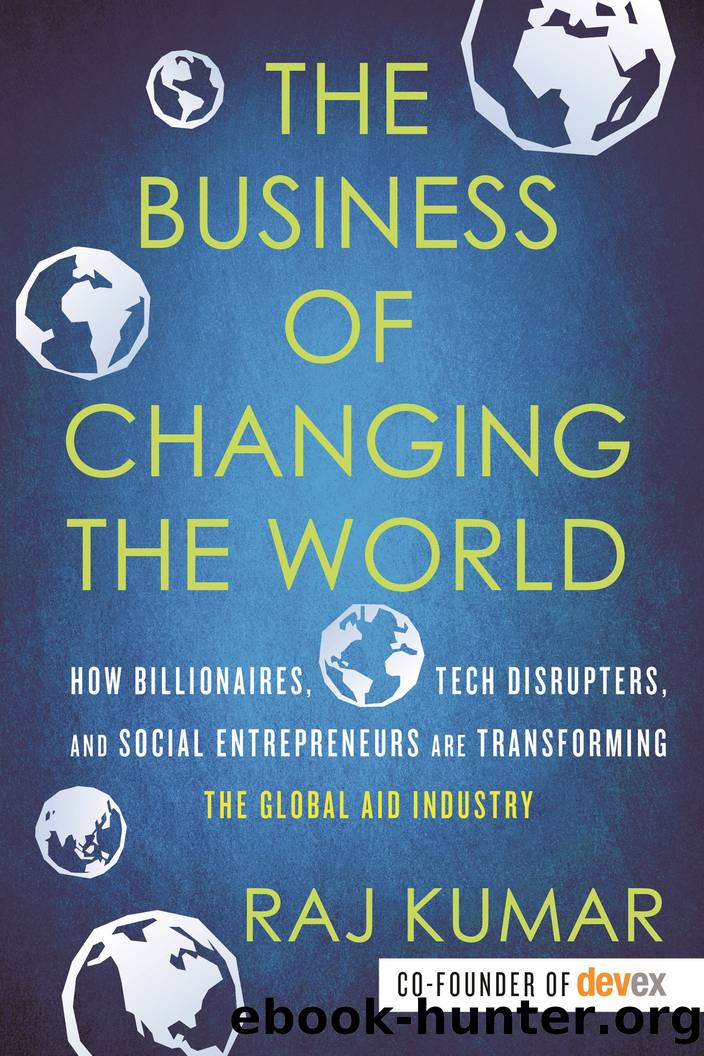The Business of Changing the World by Raj Kumar

Author:Raj Kumar [Kumar, Raj]
Language: eng
Format: epub
Publisher: Beacon Press
GETTING TO SCALE
This issue of scale is dear to the hearts of billionaires and entrepreneurs, many of whom made their wealth in Silicon Valley. The goal in Silicon Valley is to build solutions that can ultimately reach every human, every business, every country. With the increasing cross pollination between Silicon Valley and philanthropy, this obsession with scale has entered the DNA of the global development community.
Real status in the aid industry now belongs to those who seek to create solutions that can scale to tackle problems like those outlined in the Sustainable Development Goals. Bill Gates is working to end polio; Mike Bloomberg, smoking; Mark Zuckerberg, disease; George Soros, oppression; Chris Hohn, the British hedge fund investor behind the Children’s Investment Fund Foundation, child deaths. Smaller-scale tutoring programs are fine, but making them accessible to millions of kids in thousands of communities (say, through something like Khan Academy)—that’s the Silicon Valley way.
Scale is important in global development and business for similar reasons: to bring down costs and build up capital. Walmart can’t lower its prices much as a single department store. With thousands of stores, it has the buying power to change entire industries and supply chains, lowering prices for millions of consumers.
Traditional aid organizations can find it difficult to scale their activities. Yes, the cost per bed net would be lower if you bought millions of them, but the total amount of money required to buy that many is much greater and perhaps not within the project budget. The old aid mind-set is based on what the famed humanitarian doctor Paul Farmer, cofounder of Partners In Health, calls the “socialization of scarcity”—the idea that we are all competing for scarce resources and all have to make do with less.15 Because this worldview was so embedded in organizations constantly appealing for more donations, aid organizations rarely thought big in the way that is so common in Silicon Valley. On the West Coast there’s even a term for this mind-set—“abundant thinking.” The predominant feeling among NGOs and aid workers was that money is always tight, so don’t shoot for big things.
In a world where a single family—Mark Zuckerberg and Priscilla Chan—will likely contribute over $100 billion to charitable work, ordinary people have loaned $1 billion through the microfinance platform Kiva, and Americans donated $500 million via their cell phones to earthquake relief in Haiti in just a few days, or where some $9 trillion is invested in socially responsible investments, scarcity isn’t the issue any longer.
There’s enormous potential for tackling the biggest problems, extreme poverty included, in retail models. These models don’t just have to rely on donations. The new money will also come from ordinary people in the form of loans, remittances, investments, or purchasing power. Foreign aid and billionaire contributions will still be critical—in part because they can fund important public goods but also because they can seed the kinds of organizations and models that will unlock this retail money.
It’s not all about donations either. A key milestone for
Download
This site does not store any files on its server. We only index and link to content provided by other sites. Please contact the content providers to delete copyright contents if any and email us, we'll remove relevant links or contents immediately.
| General | Discrimination & Racism |
Nudge - Improving Decisions about Health, Wealth, and Happiness by Thaler Sunstein(6627)
iGen by Jean M. Twenge(4692)
The Fire Next Time by James Baldwin(4336)
Adulting by Kelly Williams Brown(3662)
The Sports Rules Book by Human Kinetics(3580)
The Hacking of the American Mind by Robert H. Lustig(3572)
The Ethical Slut by Janet W. Hardy(3492)
Captivate by Vanessa Van Edwards(3290)
Mummy Knew by Lisa James(3162)
In a Sunburned Country by Bill Bryson(2940)
Ants Among Elephants by Sujatha Gidla(2919)
The Worm at the Core by Sheldon Solomon(2910)
Suicide: A Study in Sociology by Emile Durkheim(2604)
The Slow Fix: Solve Problems, Work Smarter, and Live Better In a World Addicted to Speed by Carl Honore(2569)
Humans of New York by Brandon Stanton(2376)
Handbook of Forensic Sociology and Psychology by Stephen J. Morewitz & Mark L. Goldstein(2376)
Blackwell Companion to Sociology, The by Judith R. Blau(2313)
The Happy Hooker by Xaviera Hollander(2270)
Outliers by Malcolm Gladwell(2252)
